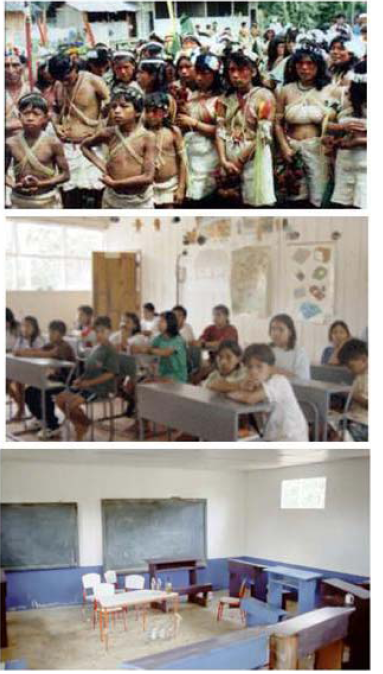Anthropologist Laura Rival describes the establishment of a school by a group of Christian missionaries. Following is an example of a school performing an assimilating role in the transformation of the lifeways of an indigenous community.

Anthropologist Laura Rival describes the establishment of a school by a group of Christian missionaries. Following is an example of a school performing an assimilating role in the transformation of the lifeways of an indigenous community.

The schools found in Huaorani land … are conceived as models of modern culture. With their concrete floors, plank walls, and corrugated iron roofs, they are the only ‘modern’ buildings in the village, and house all that is … ‘foreign’. The school village, clustered around the schoolhouse and the airstrip, is linked to the provincial capital by modern systems of communication and transport—contact-radios and airplanes. The schoolhouse … is flanked on one side, by an experimental plantation in which children—and their parents—learn to cultivate new tropical plants and cash crops. On the other side, a school canteen is equipped with the modern cooking and serving implements necessary for the preparation of ‘proper’ meals and modern eating.
People are also … the targets of modernization … [T]he Ecuadorian government despite its limited budget, regards the education of a ‘deprived’ and ‘backward’ population such as the Huaorani as a priority … [T]he government has ordered the allocation … of medicine, clothes, soap, toothbrushes, toothpaste and food considered nutritious to all school villages.
There exists a striking consensus between the teachers and the Huaorani communities on one point: to be educated is to be modern, and to be modern means to consume imported, manufactured goods. For the teachers, the very low rates of proficient literacy and numeracy among the Huaorani, even after the completion of six years of primary education, are not caused by curriculum deficiency, but due to a lack of modern socialization. Formal education, however good the program, they argue, will not be effective if Huaorani children have not acquired the discipline and concentration that mental work demands, that is, if they have not become ‘modern’ and ‘civilized’. To teach Huaorani children the general cognitive skills of reading, writing, and counting requires not only their disembedding from the context of daily life … but, more specifically from the context of the forest and longhouse.
Schoolchildren … learn to be modern by memorizing textbook lessons of hygiene, executing school commands and … by imitating the teachers. The teachers’ ways of waking up and dressing, washing, cooking and eating, playing the guitar, conversing, reading, and listening to the radio, are scrutinized and endlessly commented upon …
For Huaorani parents and children … competent literacy and numeracy are correlated with the acquisition of new lifestyle, inscribed in the way one dresses, eats, and behaves. To learn new skills is to learn an new identity so one becomes at once educated, modern, and ‘civilized’. Villagers of all ages avoid the schoolhouse if not wearing bright and clan clothes, even if this involved long detours. And no one approaches the school compound without first combing one’s hair and washing off the mud from one’s legs and feet.
Rival, Laura. 1996. ‘Formal Schooling and the Production of Modern Citizens in the Ecuadorian Amazon. Pp. 153–167 in The Cultural Production of the Educated Person, edited by B. Levinson, D. Foley, and D. Holland. Albany NY: State University of New York Press. pp. 153, 156–158. || Amazon || WorldCat